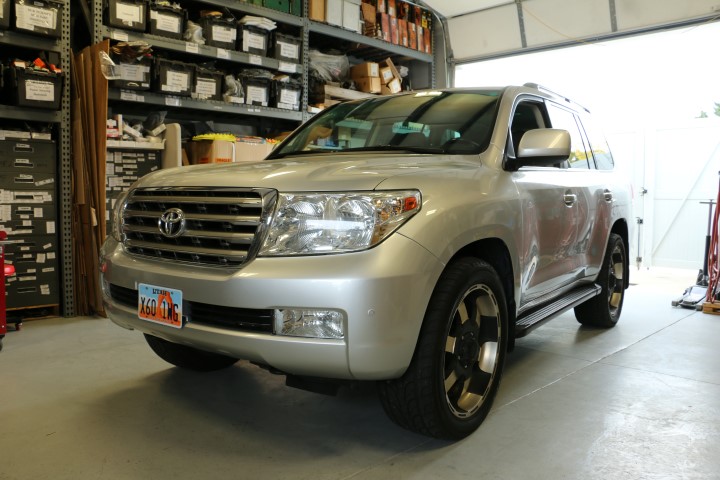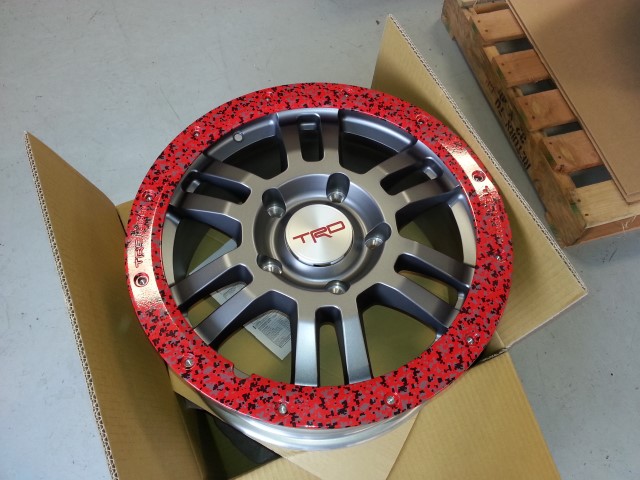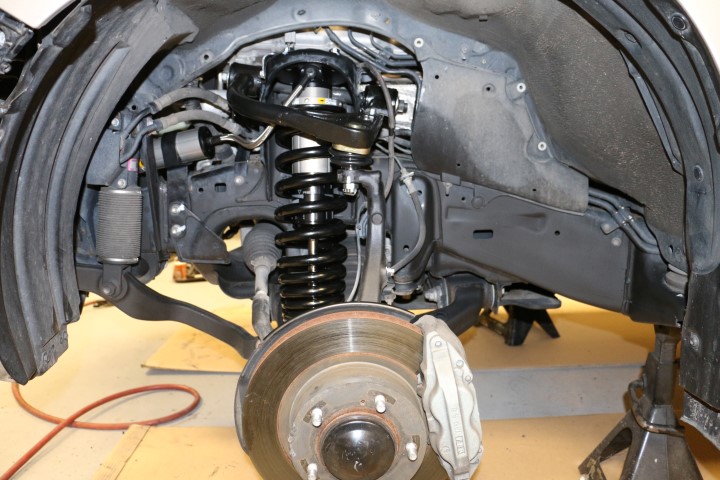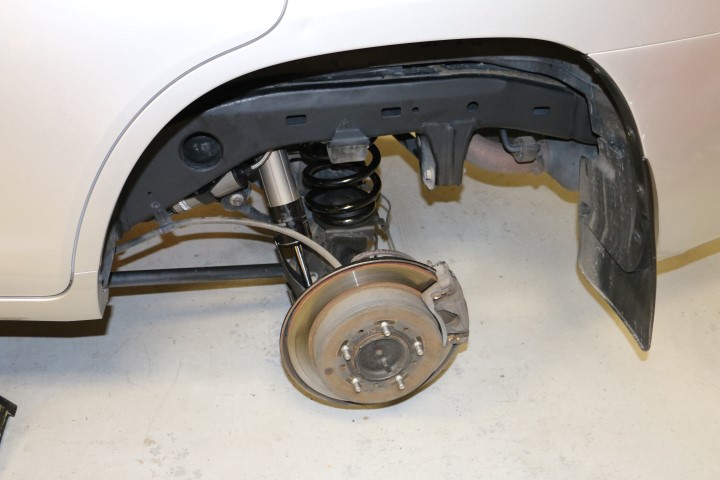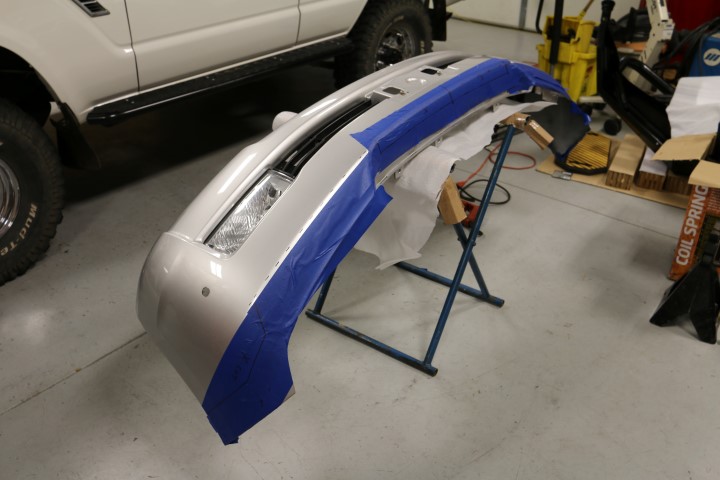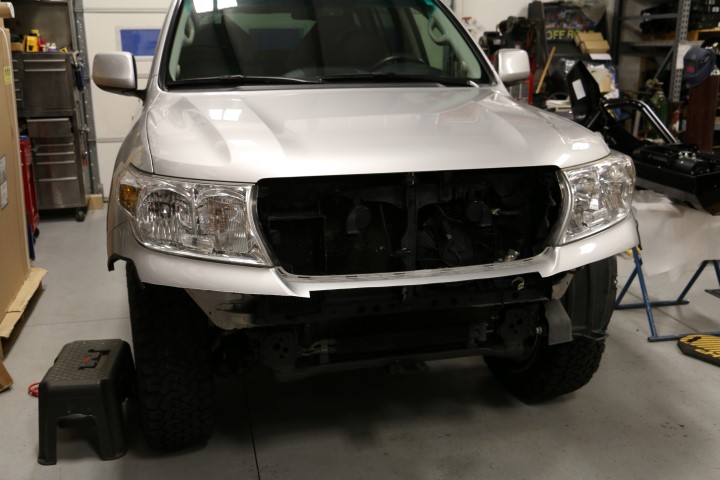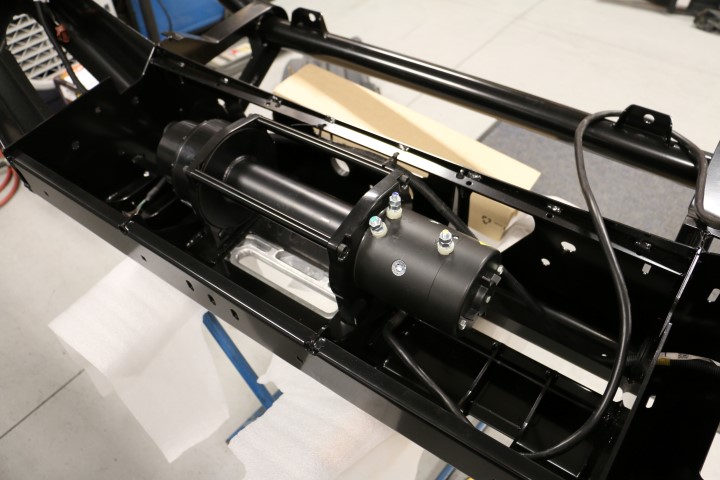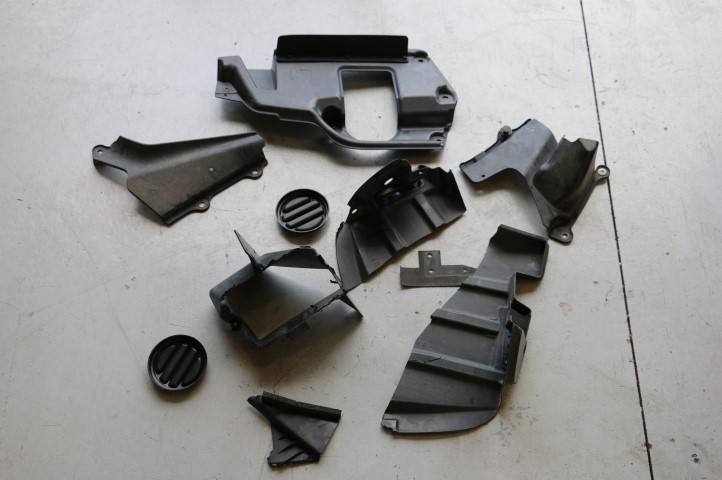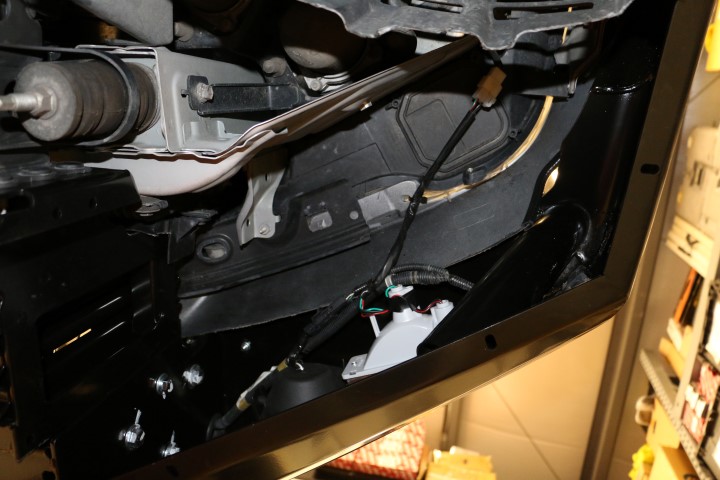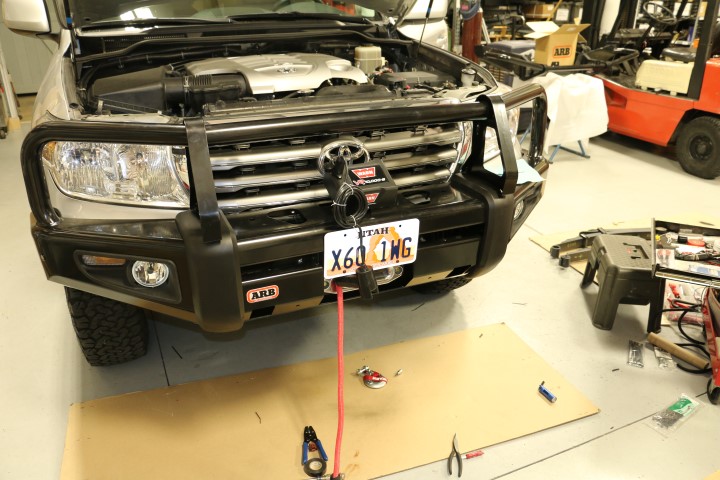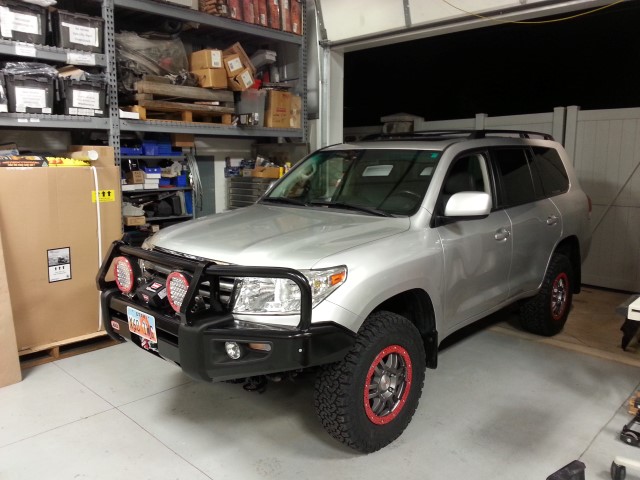cruiseroutfit
Well-known member
Stage One - Maintenance & Baseline:

All the signs of a leaking water pump.
I purchased the 200 private party and while it came with decent service records, I wanted to baseline the fluids and swap the air, oil and cabin air filter, a fresh start. While climbing around the undercarriage during the oil change I noticed a trail of dried up pink coolant coming down the face of the motor. The leak was easily traced back up towards the top of the block, leaking from the weep hole of the water pump. I had an Aisin water pump and gasket on the shelf in the shop so the swap was really just a few hours of shop time and some coolant. We went ahead and swapped the fan bracket while doing the water pump, the bearing had been exposed to the leaking coolant and I didn't want to have to do the job twice. The 5.7L (3UR) is somewhat known for water pump weeps around the 100k mark and they give plenty of warning, don't really ever catastrophically fail and are easy enough to change... not a deal breaker.

The old parts, ready for the scrap bin.
I have had a slight side view mirror shake at high speeds that I need to resolve. Toyota has produced a Technical Service Bulletin kit to remedy this exact situation, I have the parts and need to get around to installing them. Lastly, I have a slight "thunk" coming from the rear driveline, also a somewhat common annoyance found on the 80, 100 and now the 200 Series Land Cruiser. Many (most?) live with it, an occasional re-grease will quiet the problem for quite some time. Others choose to replace the driveline and it's worn slip-joint assembly to resolve the thunk permanently. Again, Toyota has a TSB dealing with the thunk but my 2008 was outside the window of free replacement so I simply greased it up and went on my way. I'll revisit the rear drive line later if it presents a problem down the road.
Stage Two - Upgrade & Refine: Developing the Build Plan
Perhaps I over-think things? Perhaps I under-think them? I simply desire to make sure I'm adding things to the Cruiser that are worthwhile for my planned uses, stalwart and up to the rigors of the way I plan to use the vehicle and lastly a good aesthetic fit without any compromise for function. The build plan is pretty straight forward, repeat everything I liked about my 100 Series Land Cruiser build and table a few items that I haven't quite solidified my opinion on.

The "Death Star" 100 Series. The vehicle the 200 will eventually replace - Photo by Bart W.
Some of this is a direct repeat from my 100 Series build as the ideology remains exactly the same. I'm a big proponent of planning ones vehicle build long before you turn the first bolt. All to often I'm discussing a customers Land Cruiser plan and they ask "What would you do next?". It is by all means a valid question and I appreciate their trust in my opinion and product knowledge but while some items can suggested others need to be developed solely on the needs of the end user themselves. For example I can tell a customer they need to replace their shocks based on a few questions or suggest tie rod ends get replaced based on a quick inspection. However, questions like "What accessory should I do next?" are generally a launching pad for me to discuss a "build plan" with the customer. We do "build plans" on the phone with customers on a daily basis, rebuilding a Land Cruiser front axle and we'll go through our build sheet to make sure we are covering all your parts needs. Looking to install an Old Man Emu suspension and we'll spend 15-20 minutes talking about your past, current and future vehicle uses, loads, accessories, etc and from there we'll recommend the right components. But why not use this same logic on a complete vehicle build? Why not pull up a chair next to your rig in the driveway and start making notes. What do you want out of your rig? What didn't you like about the one you just sold or will be selling? What made you purchase this one? What needs do you need to build around? While it might sound a little naive for some, I think many can benefit. It doesn't matter whether your build is going to take a weekend or a few years, after all "A goal without a plan is just a wish" (stolen from Antoine de Saint-Exupery)
Back to the 200 build. What did I need? What did want? What did I love about my 100 Series and what did dislike about it at the same time? Just like the 100, this vehicle will see far more time bombing down dirt roads in high range than it will crawling in technical rocks in low range. It will support 1-4 adults, their gear and food on anything from an overnight trip to a week+ self supported trip out out of country. I envision owning the vehicle for the next 3-5 years. While it won't necessarily be a daily driver, I want it to be comfortable, reliable and ready. My wife may use it from time to time on her mountain biking adventures and we might load the dog in the back and head to the hills for a short hike after work, versatility is fundamental. With that said I've decided to touch on a few of the major categories for my build plan and add a few notes about their importance for my needs.
Armor & Protection: The rig would need protection, front, rear, sides and the belly. While one or several of those areas are easily ignored on the emotion of budget or lack of perceived need, if I was going to do it I was going to do it right and there wasn't a single piece of protection that wasn't used and appreciated on my 100 Series.
Roof Rack: Like many I have mixed emotions on roof racks. They produce aerodynamic drag, noise and result in loss of clearance in tight trees. However, when storage space is at a premium or a roof-top-tent is an option, a roof rack is mandatory. When not in use a quality rack is generally easy to remove. Given my criteria to have one weeks worth of gear for 4 adults for a trip this month, a rack was included in my build plan.
Suspension, Wheel & Tire: With the anticipated loads I expected to carry along with the additional height needed to allow a larger tire and additional ground clearance, a quality, reliable and sturdy suspension were mandatory. With the increased room I hoped to achieve with the suspension I wanted to run a strong wheel that met my aesthetic needs and a tire matched to the job. This truck will bounce between long stretches on the Interstate and hundreds of miles of dirt road, I needed a tire that was capable of providing reliability and function in both scenarios.
Shower System: I've had lines of grungy camp mates lining up to take a quick rinse with hot water, a godsend after a few days in a dusty line of vehicles for men and women alike. While its an easy sell to the misses for those married folks, its also an easy sell to anyone that has every used one. I've installed one on each of my vehicles since, absolutely no reason this one would be different even if space under the hood would be a premium with the other plans.
Snorkel/Waterproofing: Some love them, some hate them, I'm not hear to convince either way however for my needs and intended uses its a need. If your interested in more of my thoughts on snorkels, please see an article I wrote in the past for for Tacoma Magazine.
Lighting: Both the interior factory lights as well as additional exterior auxiliary lighting would need to be improved and installed. Lights on the front bumper for added nighttime driving comfort as well as a manually switchable light for the rear of the vehicle that allows for use as a reverse light as well as a camp light.
Storage: This is one area I really feel like I nailed in the 100. The rear drawers, fridge slide and cubby panels have proven super versatile, secure and tidy. I had my packing down to a science; bins, bags and gear fit in exact spots and I could load or unload in a haste and all the while it served as a stellar sleeping platform. I've covered a bit more of my packing protocol here.
Winch: My travels often find me in some pretty remote locations, possibly in a group or possible solo with nothing but the wolves to keep me company. While we all hope for the best outcome to any situation, its naive to plan for anything but the worst. The winch would need to be matched for the demands and rated for the heavy rig.
Wheel/Fuel Carrier: A full-size spare was mandatory for this build. Between the full-time 4WD which can be damaged but mis-matched tires and the need for comfortable road manners when we are days away from home, there was no other option. This dictates the need for a rear bumper tire carrier which also gives the added benefit of increased ground clearance under the vehicle or the future option for an secondary fuel tank. Given the criteria in my build plan for a tire carrier, a jerry can holder was also mandated to add to the fuel range or carry water outside what will become a stuffed cab. and increased.
Communication & 12V Equipment: Both for personal uses out on the trial as well as this trucks service as a desert race chase, this vehicle needs a full communication suite consisting of a high output HAM unit (modded for use in the race circuit) and a CB radio for general trail duties on future trips. Our modern tech age dictates the need for addition 12V & USB outlets for charging phones, camp lights, GPS power, etc. These would be placed in strategic locations to allow use at the rear as well as by passengers inside the cab. With all the added electrical load as well as the potential for this vehicle to sit boondocked at a camp in the middle of nowhere for days, a dual battery system is included in my build plan. Dual batteries provide not only the added reserve capacity for electronics while the vehicle is not charging (not running) but also provide redundancy in the case of a battery failure and provide a needed second battery for welding with products such as the Ready Welder.
12V Fridge: I could go on and on about my needs for a fridge but I've summed up my thoughts here: RME: 12V Freezer-Fridges - Do they bring the heat?
This covers all the major components I planned to conquer within the scope of my "Phase 1". I'm literally planning to not have any other projects once phase 1 is complete. I'll use it for 6-12 months and if/when there are needs from there. Note: These are my build needs, yours may, could and should vary.
Next Up: The fun begins; Choosing & ordering the build components

Parts are starting to pile up!

All the signs of a leaking water pump.
I purchased the 200 private party and while it came with decent service records, I wanted to baseline the fluids and swap the air, oil and cabin air filter, a fresh start. While climbing around the undercarriage during the oil change I noticed a trail of dried up pink coolant coming down the face of the motor. The leak was easily traced back up towards the top of the block, leaking from the weep hole of the water pump. I had an Aisin water pump and gasket on the shelf in the shop so the swap was really just a few hours of shop time and some coolant. We went ahead and swapped the fan bracket while doing the water pump, the bearing had been exposed to the leaking coolant and I didn't want to have to do the job twice. The 5.7L (3UR) is somewhat known for water pump weeps around the 100k mark and they give plenty of warning, don't really ever catastrophically fail and are easy enough to change... not a deal breaker.

The old parts, ready for the scrap bin.
I have had a slight side view mirror shake at high speeds that I need to resolve. Toyota has produced a Technical Service Bulletin kit to remedy this exact situation, I have the parts and need to get around to installing them. Lastly, I have a slight "thunk" coming from the rear driveline, also a somewhat common annoyance found on the 80, 100 and now the 200 Series Land Cruiser. Many (most?) live with it, an occasional re-grease will quiet the problem for quite some time. Others choose to replace the driveline and it's worn slip-joint assembly to resolve the thunk permanently. Again, Toyota has a TSB dealing with the thunk but my 2008 was outside the window of free replacement so I simply greased it up and went on my way. I'll revisit the rear drive line later if it presents a problem down the road.
Stage Two - Upgrade & Refine: Developing the Build Plan
Perhaps I over-think things? Perhaps I under-think them? I simply desire to make sure I'm adding things to the Cruiser that are worthwhile for my planned uses, stalwart and up to the rigors of the way I plan to use the vehicle and lastly a good aesthetic fit without any compromise for function. The build plan is pretty straight forward, repeat everything I liked about my 100 Series Land Cruiser build and table a few items that I haven't quite solidified my opinion on.

The "Death Star" 100 Series. The vehicle the 200 will eventually replace - Photo by Bart W.
Some of this is a direct repeat from my 100 Series build as the ideology remains exactly the same. I'm a big proponent of planning ones vehicle build long before you turn the first bolt. All to often I'm discussing a customers Land Cruiser plan and they ask "What would you do next?". It is by all means a valid question and I appreciate their trust in my opinion and product knowledge but while some items can suggested others need to be developed solely on the needs of the end user themselves. For example I can tell a customer they need to replace their shocks based on a few questions or suggest tie rod ends get replaced based on a quick inspection. However, questions like "What accessory should I do next?" are generally a launching pad for me to discuss a "build plan" with the customer. We do "build plans" on the phone with customers on a daily basis, rebuilding a Land Cruiser front axle and we'll go through our build sheet to make sure we are covering all your parts needs. Looking to install an Old Man Emu suspension and we'll spend 15-20 minutes talking about your past, current and future vehicle uses, loads, accessories, etc and from there we'll recommend the right components. But why not use this same logic on a complete vehicle build? Why not pull up a chair next to your rig in the driveway and start making notes. What do you want out of your rig? What didn't you like about the one you just sold or will be selling? What made you purchase this one? What needs do you need to build around? While it might sound a little naive for some, I think many can benefit. It doesn't matter whether your build is going to take a weekend or a few years, after all "A goal without a plan is just a wish" (stolen from Antoine de Saint-Exupery)
Back to the 200 build. What did I need? What did want? What did I love about my 100 Series and what did dislike about it at the same time? Just like the 100, this vehicle will see far more time bombing down dirt roads in high range than it will crawling in technical rocks in low range. It will support 1-4 adults, their gear and food on anything from an overnight trip to a week+ self supported trip out out of country. I envision owning the vehicle for the next 3-5 years. While it won't necessarily be a daily driver, I want it to be comfortable, reliable and ready. My wife may use it from time to time on her mountain biking adventures and we might load the dog in the back and head to the hills for a short hike after work, versatility is fundamental. With that said I've decided to touch on a few of the major categories for my build plan and add a few notes about their importance for my needs.
Armor & Protection: The rig would need protection, front, rear, sides and the belly. While one or several of those areas are easily ignored on the emotion of budget or lack of perceived need, if I was going to do it I was going to do it right and there wasn't a single piece of protection that wasn't used and appreciated on my 100 Series.
Roof Rack: Like many I have mixed emotions on roof racks. They produce aerodynamic drag, noise and result in loss of clearance in tight trees. However, when storage space is at a premium or a roof-top-tent is an option, a roof rack is mandatory. When not in use a quality rack is generally easy to remove. Given my criteria to have one weeks worth of gear for 4 adults for a trip this month, a rack was included in my build plan.
Suspension, Wheel & Tire: With the anticipated loads I expected to carry along with the additional height needed to allow a larger tire and additional ground clearance, a quality, reliable and sturdy suspension were mandatory. With the increased room I hoped to achieve with the suspension I wanted to run a strong wheel that met my aesthetic needs and a tire matched to the job. This truck will bounce between long stretches on the Interstate and hundreds of miles of dirt road, I needed a tire that was capable of providing reliability and function in both scenarios.
Shower System: I've had lines of grungy camp mates lining up to take a quick rinse with hot water, a godsend after a few days in a dusty line of vehicles for men and women alike. While its an easy sell to the misses for those married folks, its also an easy sell to anyone that has every used one. I've installed one on each of my vehicles since, absolutely no reason this one would be different even if space under the hood would be a premium with the other plans.
Snorkel/Waterproofing: Some love them, some hate them, I'm not hear to convince either way however for my needs and intended uses its a need. If your interested in more of my thoughts on snorkels, please see an article I wrote in the past for for Tacoma Magazine.
Lighting: Both the interior factory lights as well as additional exterior auxiliary lighting would need to be improved and installed. Lights on the front bumper for added nighttime driving comfort as well as a manually switchable light for the rear of the vehicle that allows for use as a reverse light as well as a camp light.
Storage: This is one area I really feel like I nailed in the 100. The rear drawers, fridge slide and cubby panels have proven super versatile, secure and tidy. I had my packing down to a science; bins, bags and gear fit in exact spots and I could load or unload in a haste and all the while it served as a stellar sleeping platform. I've covered a bit more of my packing protocol here.
Winch: My travels often find me in some pretty remote locations, possibly in a group or possible solo with nothing but the wolves to keep me company. While we all hope for the best outcome to any situation, its naive to plan for anything but the worst. The winch would need to be matched for the demands and rated for the heavy rig.
Wheel/Fuel Carrier: A full-size spare was mandatory for this build. Between the full-time 4WD which can be damaged but mis-matched tires and the need for comfortable road manners when we are days away from home, there was no other option. This dictates the need for a rear bumper tire carrier which also gives the added benefit of increased ground clearance under the vehicle or the future option for an secondary fuel tank. Given the criteria in my build plan for a tire carrier, a jerry can holder was also mandated to add to the fuel range or carry water outside what will become a stuffed cab. and increased.
Communication & 12V Equipment: Both for personal uses out on the trial as well as this trucks service as a desert race chase, this vehicle needs a full communication suite consisting of a high output HAM unit (modded for use in the race circuit) and a CB radio for general trail duties on future trips. Our modern tech age dictates the need for addition 12V & USB outlets for charging phones, camp lights, GPS power, etc. These would be placed in strategic locations to allow use at the rear as well as by passengers inside the cab. With all the added electrical load as well as the potential for this vehicle to sit boondocked at a camp in the middle of nowhere for days, a dual battery system is included in my build plan. Dual batteries provide not only the added reserve capacity for electronics while the vehicle is not charging (not running) but also provide redundancy in the case of a battery failure and provide a needed second battery for welding with products such as the Ready Welder.
12V Fridge: I could go on and on about my needs for a fridge but I've summed up my thoughts here: RME: 12V Freezer-Fridges - Do they bring the heat?
This covers all the major components I planned to conquer within the scope of my "Phase 1". I'm literally planning to not have any other projects once phase 1 is complete. I'll use it for 6-12 months and if/when there are needs from there. Note: These are my build needs, yours may, could and should vary.
Next Up: The fun begins; Choosing & ordering the build components

Parts are starting to pile up!






